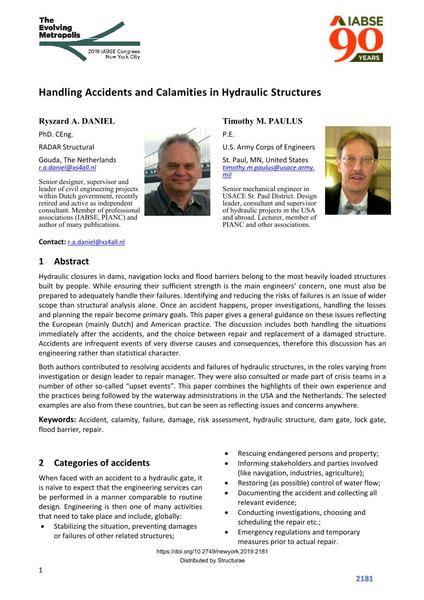Handling Accidents and Calamities in Hydraulic Structures

|
|
|||||||||||
Bibliografische Angaben
| Autor(en): |
Ryszard A. Daniel
(RADAR Structural)
Timothy M. Paulus (U.S. Army Corps of Engineers) |
||||
|---|---|---|---|---|---|
| Medium: | Tagungsbeitrag | ||||
| Sprache(n): | Englisch | ||||
| Tagung: | IABSE Congress: The Evolving Metropolis, New York, NY, USA, 4-6 September 2019 | ||||
| Veröffentlicht in: | The Evolving Metropolis | ||||
|
|||||
| Seite(n): | 2181-2186 | ||||
| Anzahl der Seiten (im PDF): | 6 | ||||
| DOI: | 10.2749/newyork.2019.2181 | ||||
| Abstrakt: |
Hydraulic closures in dams, navigation locks and flood barriers belong to the most heavily loaded structures built by people. While ensuring their sufficient strength is the main engineers’ concern, one must also be prepared to adequately handle their failures. Identifying and reducing the risks of failures is an issue of wider scope than structural analysis alone. Once an accident happens, proper investigations, handling the losses and planning the repair become primary goals. This paper gives a general guidance on these issues reflecting the European (mainly Dutch) and American practice. The discussion includes both handling the situations immediately after the accidents, and the choice between repair and replacement of a damaged structure. Accidents are infrequent events of very diverse causes and consequences, therefore this discussion has an engineering rather than statistical character. Both authors contributed to resolving accidents and failures of hydraulic structures, in the roles varying from investigation or design leader to repair manager. They were also consulted or made part of crisis teams in a number of other so-called “upset events”. This paper combines the highlights of their own experience and the practices being followed by the waterway administrations in the USA and the Netherlands. The selected examples are also from these countries, but can be seen as reflecting issues and concerns anywhere. |
||||
| Stichwörter: |
Risikobewertung Versagen Schaden Reparatur Unfall Wasserbauwerk
|
||||
